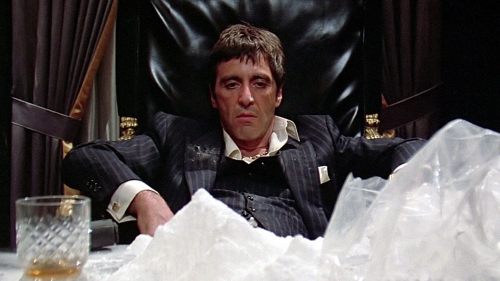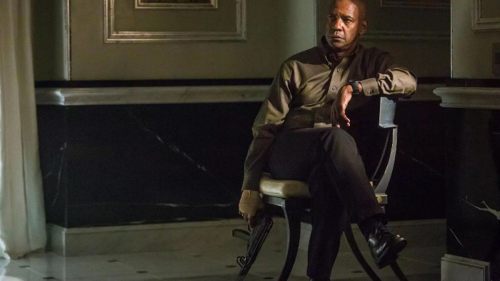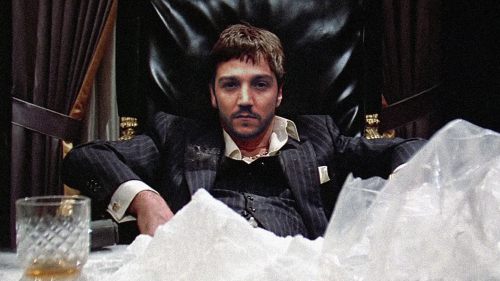Little Big Man: Brian De Palma’s SCARFACE
De Palma is out in theaters now (you can buy your tickets here). In honor of the documentary's legendary subject, we're kicking off a week-long look at the director's classic - and not so classic - films.
When we first meet Tony Montana, the Cuban crime prince of Brian De Palma’s Scarface, it’s in close-up, the camera rotating 360 degrees around the refugee as three white men crudely cross-examine him at a customs port. An evacuee during the ‘80 Mariel Boatlift, Montana’s come to Florida seeking shelter from Communism and Castro. The man is all Latin virility, radiating the kind of tough guy flair a Prohibition-era bootlegger would admire (should elemental racism allow). Only Montana’s not played by an actual Latino actor, but Al Pacino – a highly successful Academy Award Nominee of Italian descent from the Bronx. Bronzed into oblivion, Pacino’s brown eyes flash and convey a brash confidence. Montana’s holding court from the first frame, even as his interrogators attempt to break him. In the movie’s earliest moments, De Palma is relying on the sheer will of his star to both captivate us with this bad man’s arrogance, and also make us forget that we’re watching a rather aggressive example of big studio brown-face.
Or maybe we’re supposed to notice? Truthfully, Pacino succeeds and then some, creating an icon in Scarface’s titular thug by simply being Al Pacino. One of the most fascinating interpretations of the megastar’s blustery, profanity-laced bit of scenery chewing comes from Karina Longworth, who translates the actor’s own “Brechtian” description of his performance. “In this case, ‘Brechtian’ means that Tony Montana was not intended to be a character that was identified with,” Longworth states in her stellar book on the performer, “but instead looked at from an emotional remove.”
This undoubtedly seems to be the case, but Pacino is also individually connecting to the role via Strasberg’s Method – linking back to his time living in the Bronx with a divorced mother and her two immigrant parents from Corleone, Sicily. He was a short kid who grew into a short man; a physical trait not usually seen by actors as being advantageous. So while we’re surely supposed to view this Napoleonic, straight off the boat kingpin-to-be from arm’s length, we’re never unaware of the fact that he knows how ridiculous he looks. Nevertheless, Montana’s going to buck against every insult slung in his direction by these wide-waisted, no style white men with the force of ten thousand horses, never letting them in on the insecurities that haunt him to his core. While still morally questionable, the brown-face (not to mention the constant “meng” peppered faux Cubano slang) actually accentuates just how much overcompensation is going into the role for us to not completely dismiss it as ludicrous from the jump.
Everything about Scarface is BIG. No decision Brian De Palma makes is less than operatic. Though we meet Tony in close-up, much of his early journey is told through the widest of lenses, harnessed to cranes. The rigs soar over refugee holding camps like Freedomtown (where Tony pulls off a hit on one of Castro’s former allies in order to secure a Green Card), and climb up the back porches of sun soaked roach motels, where keys of yayo change hands with cash and blood. The only time we zoom back in on Tony is when he’s forced to witness horrific carnage, gore splashing on his face as his good friend Chi Chi (Ángel Salazar) is chain-sawed to death in a bathtub (keeping the ’73 dialogue* the director began with Alfred Hitchcock’s Psycho going). Everything else is captured with an engulfing eye for neon madness, as DP John A. Alonzo’s camera hovers about this diminutive but explosive man as he shoots his way to the top, colorfully expressing himself with words that would cause a Catholic schoolteacher to faint.
This massive world is one of baroquely colorful crime lords, all grandiloquence and bad threads. Every actor on set is garishly channeling the spirits of Paul Muni and James Cagney, updating the screen icons for an era of white powder and red shag carpeting. Michelle Pfeiffer (playing the girlfriend of curious blowhard, Frank Lopez – played by fellow Italian American, Robert Loggia) is filmed at all times like a trophy dame, every golden hair perfectly in place. The dresses she wears shimmer as the woman’s eyes die, line upon line snorted up her nose so that she can stand more of Frank and his lackeys’ bullshit. Like Pacino’s Tony Montana, her Elvira Hancock (Jesus, what a name) is a jittery ball of nerves, knowing just how these pig men view her: nothing but a pretty thing to be slung on their arm. However, there’s also a sad resignation to the way Elvira drifts through her surroundings, like the ghost of a great seductress, knowing she’s won a prize she may have never truly desired. The wild nights, the parties, the drinking and the coke were all fun, but now she’s stuck with an addiction she doesn’t care to kick, and a gaggle of slobs who drool over her whenever she enters a room. But what’s she going to do: get a job, kick the habit, and say no to free money from these fat fucks? The life of being a gangster’s best girl is a habit unto itself, and surely better than the impoverished alternative.
Elvira represents everything Tony wants to be, but never can, rendering his macho posturing all the more preposterous. High class, educated, and hailing from Baltimore (a city Tony didn’t even know existed until they met), Elvira’s privileged status further magnifies her unattainable stature. Only Tony doesn’t just want to fuck her, he wants to be her. This is a man whose own mother disowns him because she can see straight through his nonsense cover story of being an “anti-Castro organizer”. Even a car salesman comments, “machine gun turrets are extra” when Tony purchases a luxury vehicle in hopes of impressing the femme fatale. He’s a peasant who sees the American Dream as something that doesn’t need to be worked for, but instead stolen out of the pockets of those hooked on China White. Yet money can’t buy class, no matter how much he filters through crooked bankers and invests in opulent mansions. His flashy suits are translucent raincoats, only shielding him from the blood of his numerous victims.
Brian De Palma, screenwriter Oliver Stone, and electronic composer Giorgio Moroder are in love with melodrama (the latter two having already won Oscars collaborating together on the Turkish prison picture, Midnight Express). The love triangle that forms between Tony, his sister Gina (Mary Elizabeth Mastrantonio), and Montana’s right hand, Manny (Steven Bauer), becomes a strange sidebar that again highlights just how petty and insecure the crime lord is. Tony views Gina as a symbol of innocence, and cannot stand to see another man’s hands all over her. While not explicitly sexual, it marks the short man as impotent, never wanting to let go of the girl as another possession he holds in his pocket. Of all Scarface’s old fashioned tendencies, none are more obvious than the overblown, swooning silliness that really only swells the movie’s already overstuffed shape.
Given Tony’s meteoric rise (which is scored to Paul Engemann’s “Push It to the Limit” – a song choice that would make Michael Mann blush) following a power play that pushes Frank out of the picture, it’s only fitting that the final hour of Scarface would be devoted to his fall. The blinding, extravagant wealth on display is no doubt the reason the movie has become a favorite of hip hop artists (not to mention fictional low level Florida drug lords), but the sad actuality is that the post intermission descent into decadent Hell is far less engaging than Tony’s ascent to power. Sure, the most quotably bonkers moments are contained in this pop operetta’s third act aria (“Fly pelican! Fly!”) and the final stand off is gloriously unhinged, rivaling the explosion filled battles Oliver Stone would later go on to win an Oscar for. Cops, Colombian kingpins and Tony’s own dependences ultimately lead to his demise, as the little man continues to stack shit higher than his own tallness. It’s a familiar song, cranked to eleven until you can no longer stand the gunfire, shouting and snorting, all amalgamating with Moroder’s crying synths to create a cacophony of uncut delirium.
Scarface came immediately after Brian De Palma’s defining masterwork, Blow Out, failed miserably at the box office. He was at the peak of his artistic powers, having already delivered such horror classics as Carrie and Dressed to Kill. Nevertheless, he looked at others in his class like Spielberg, Lucas, and Coppola (all of whom he considered close friends) with envy. They had all reached a level of commercial and critical success he never enjoyed. Meanwhile, he was jumping genres, leaving his trademark thrillers seemingly out of a fit of boredom or an attempt to cross over attempting something new (a feat he had unsuccessfully tried before with The Fury, as he was disappointed that Carrie didn’t become the next Jaws**). In this way, Tony Montana almost acts as a perfect stand-in for Brian De Palma at this point in his career. Scarface is the director’s overcompensation for the fact that the was the black sheep of the American New Wave. He was a little man who knew he could be big, and flexed every grotesque muscle he could in order to try and prove it.
Sadly, Scarface was viewed as yet another critical and commercial misfire upon initial release in ’83. Even Pauline Kael, a staunch defender of De Palma’s throughout the years, commented in her review that the film’s scenes were “so shapeless, that we don’t know at what point we’re supposed to laugh.” The film barely made back its rather sizable production budget ($25 million), and would only earn its reputation and cult following via videocassette. In a strange bit of irony, De Palma would move back to making one of his patented thrillers (the tongue in cheek porn potboiler, Body Double) and a terrible mafia buddy comedy (Wise Guys) before returning to the gangster genre and producing one of his biggest hits to date (The Untouchables). Only there, the violence remained while the cynicism was jettisoned, resulting in a crowd pleaser that may have, in reality, left a closer resemblance to the auteur’s actual worldview in the white dust.
*Sisters being the most explicit commencement of this early, near routine homage.
**At least according to Jason Zinoman’s “Shock Value”.



